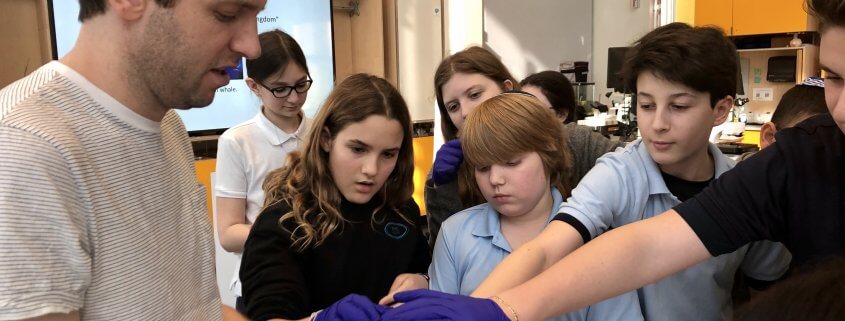Enhancing STEAM Learning with Real-World Experiences
By Allison Levine
Last Wednesday morning, the 7th grade students came to their science class prepared to learn. They took seats in the lab and listened intently and asked questions during an introductory lecture about the parts and functions of the nervous system. After that, the students collaborated on building a room-sized model of neuron chains, touched a human brain, and observed an electric fish currently being used in scientific research.
My guess is that the last couple of items on this list likely clued you in to the fact that there was something out-of-the-ordinary about this class session. And you’d be correct! What made last Wednesday’s 7th grade science class unique was that it was led by a neuroscientist (who is also a Schechter Manhattan parent) and was held in a learning lab at the Brain Institute at Columbia University.
This field trip to a neuroscience research lab exemplifies one of this year’s initiatives for the Lieberman Family STEAM Center: creating additional authentic ways for students to engage in STEAM learning by connecting them to life outside the classroom walls. In this case, authenticity translated into students learning from an expert in a STEAM field and doing so in a professional environment.
At Schechter Manhattan, we view STEAM (the integration of Science, Technology, Engineering, Art, and Math) as an interdisciplinary approach to engaging with real-world problems. We use it as a lens to teach students how to think deeply and creatively, notice connections between different subject areas, lead with empathy, and collaborate with others. These are skills and habits that we value deeply, and because of this, over the past 4 1/2 years, we have structured and restructured our work so that STEAM is a part of many aspects of a Schechter Manhattan education.
Some of the ways that STEAM appears in our school are through:
-
Problem-based, interdisciplinary units incorporated across subject areas and grade-levels
-
Coding in grades K-8 and teaching of “Maker Skills” such as robotics, engineering, 3D printing, and digital media
-
School and Community-wide STEAM events and projects (STEAMfest and Family STEAM Night)
-
Partnership programs with organizations and opportunities to learn from professionals in STEAM fields
As we increase the points at which STEAM engages with many curricular elements in our students’ learning, we also think about ways to increase authenticity — that is, to connect their learning to the world around them and outside of our classroom walls.
Two years ago, we added additional elements of authenticity to our middle school STEAMfest. (STEAMfest is a long term project, in which students identify real-world problems, conduct research, and build, test, refine, and present prototype solutions to the problem over several weeks.) We connected each group of students with an expert or “need-knower” on their topic, and had the students conduct interviews with them via email. The students used the information they received to inform their design choices. We also organized a panel of evaluators, made up of faculty and parents who work in STEAM fields, to provide feedback on the final projects.
This same year, we also started a STEAM Advisory Committee, made up of Schechter Manhattan parents who have education or work experience in a STEAM-related field. Members of the committee served as and connected us to guest speakers and volunteered with aspects of STEAM events.
One year ago, we began a partnership with The Center for Architecture. Our 1st grade students got to learn about architectural features of buildings and work on engineering skills, under the guidance of an architect-educator from the program.
This year, we continue to move forward with and expand upon our initiative of bringing authentic experiences to the STEAM Center.
In the fall, architect-educators from the Center for Architecture returned to our school for a 10-week residency with our 4th and 5th graders. Through the process of constructing scale models of villages using natural materials and certain engineering techniques, the students learned about what Lenape life and culture in New York was like during the 1600s.
We also restructured our STEAM Advisory Committee (now renamed STEAM Resource Group) to include 3 distinct branches of focus: School and Community Events, Partnerships, and Curriculum Enhancement. This new structure will allow for more specialized attention on these different areas of our program. Last week, members of this group attended our kick-off meeting and contributed many creative ideas for how to bring more real-world experiences to our students from Gan to 8th grade.
Finally, we are actively working on deepening some of the real-world components of Middle School STEAMfest. We are planning on having our students design solutions for actual clients and participate in more conversations with the people for whom they are designing. We have been in communication with organizations who are willing and excited to work with our Middle Schoolers as they explore challenges connected to aging in NYC.
As we continue to plan for the future of the Lieberman Family STEAM Center, we do our best to ensure that our students’ learning continues to be purpose-driven, meaningful, and serves as preparation for the 21st century challenges and careers they will inherit. We believe that the more authenticity our students’ experience in their learning, the more empowered and prepared they will be to rise to these challenges of the future.



